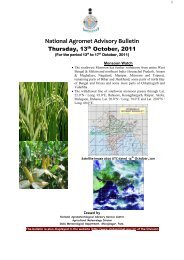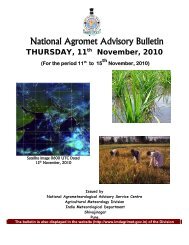You also want an ePaper? Increase the reach of your titles
YUMPU automatically turns print PDFs into web optimized ePapers that Google loves.
Executive Summary<br />
Significant rainfall occurred over many districts in Assam, Arunachal Pradesh, Himachal Pradesh, Madhya<br />
Pradesh, Chhattisgarh, Uttar Pradesh, Uttarakhand, Jharkhand, Konkan, Madhya Maharashtra, Vidarbha, Orissa,<br />
Gangetic West Bengal, Sikkim, Coastal Karnataka and Telangana and over a few districts in Jammu & Kashmir,<br />
Bihar, East Rajasthan, Gujarat region, Marathwada, Kerala and Coastal Andhra Pradesh.<br />
Rainfall is likely to occur at many places over Jammu & Kashmir, Himachal Pradesh, Uttarakhand, Uttar<br />
Pradesh, East Madhya Pradesh, Chhattisgarh, West Bengal, Bihar, Jharkhand, Orissa, Kerala, Coastal Karnataka,<br />
Konkan, Madhya Maharashtra, Vidarbha and North Eastern States. Farmers are advised to postpone irrigation,<br />
intercultural operation and application of fertilizers and plant protection measures in these States. Heavy rainfall<br />
would occur at one or two places over Uttarakhand, Uttar Pradesh, East Madhya Pradesh, Chhattisgarh and Orissa<br />
during next 48 hours. In view of occurrence of heavy rainfall in these regions, arrange for adequate drainage in<br />
standing crops.<br />
Due to subdued rainfall activities in some parts of the country during the season, contingent plan has been prepared<br />
for the farming community of Haryana, Delhi, Gujarat, Saurashtra & Kutch, West Rajasthan, Madhya Maharashtra,<br />
Marathwada, Bihar, North Interior Karnataka and South Interior Karnataka which is mentioned below:<br />
1. South Interior Karnataka: Due to insufficient rainfall, moisture stress symptoms are observed in the early<br />
sown crops. Farmers are advised to monitor the crop situation and if the rainfall condition revives, undertake<br />
resowing and if the dry weather condition persists, the standing crops may be cut and used as fodder. For<br />
resowing, select ragi (direct sowing) instead of groundnut. Also undertake sowing of red gram for vegetable<br />
purpose and fodder crops.<br />
2. North Interior Karnataka: Sowing of contingent crops is continued with realised rainfall. Undertake sowing<br />
of short duration varieties of tobacco, groundnut, maize, cowpea, sunflower, niger, castor, bajra, pigeon pea,<br />
horse gram and intercropping like bajra + redgram (2:1), pigeonpea + horsegram (2:1) or chilli + desi cotton.<br />
3. Haryana: For standing crops if rainfall does not occur, cut alternate rows of bajra crop to reduce intra crop<br />
competition for moisture and use it as fodder, so that remaining crops can survive on available soil moisture.<br />
Undertake sowing of bajra (short duration variety HHB667), urd (T9, Uttara), moth (Jwala, RMO 40, RMO<br />
257), guar (HG 563, HG 365) and fodder crops after receiving sufficient rain.<br />
4. Delhi: Continue sowing of bajra wherever rainfall occurred and farmers in areas, where rainfall did not occur,<br />
are advised to wait for sowing. Cut off dates for sowing of bajra is upto 3 rd <strong>Aug</strong>ust. After that contingent plan<br />
for vegetable crops may be worked out.<br />
5. West Rajasthan: Undertake sowing of fodder bajra and short duration varieties of moth and guar.<br />
6. Gujarat: All districts of North Gujarat zone experienced 18-20 days dry spell (from 11 th July to 31 st July).<br />
Farmers are advised to undertake mulching and thinning practices to conserve soil moisture in the early sown<br />
crops. From 31 st July, weather became very humid and sky is overcast and light scattered rainfall also<br />
continued. If the original crop has failed due to moisture stress in some districts like Banaskantha, Mehsana and<br />
Patan, carry out land preparation and sowing operations for castor, cluster bean, maize, fennel and fodder<br />
sorghum with the recent rainfall.<br />
7. Saurashtra & Kutch: Farmers of the Bhal area are advised to follow the contingency plan due to insufficient<br />
rain during the season.<br />
Paddy: Follow the SRI technique where tubewel or canal irrigation is possible<br />
Castor: Sowing of castor crop in remaining field.<br />
Fodder: Sowing of fodder crops like sorghum with high seed rate. Undertake sowing of fodder bajra,<br />
cluster beans and pulses in place of cereals.<br />
8. Madhya Maharashtra: In Ahmednagar, Dhule and Nandurbar districts, farmers are advised to undertake<br />
sowing of contingent crops like sunflower, bajra, sunflower + red gram, fodder sorghum, fodder bajra and<br />
fodder maize.<br />
9. Marathwada: Undertake sowing of kharif sunflower, soybean, bajra, sesamum instead of regular kharif crops<br />
like cotton and jowar. Undertake soil moisture conservation practices in the early sown crops.<br />
10. Bihar: Sowing of contingent crops is continued with realised rainfall. Undertake sowing of til (var. Krishna),<br />
intercropping of maize (Suwan) + urd (T-9, Pant U-31, Pant U-19) instead of upland rice, short duration verities<br />
of rice like Rajendra Bhagwati, Prabhat, Narandra 97, MTU-1010 and Rajendra Sweta in medium land and<br />
medium duration varities like Swarna Sab-1, BPT-5204, MTU-7<strong>02</strong>9, MTU-1001 and Rajshree in low land<br />
situation, vegetables like early tomato, brinjal, early cauliflower, chilli etc.<br />
Even though dry condition prevailed during initial period of the monsoon, presently good rainfall condition prevails in<br />
the following sub-divisions. In Kerala, normal monsoon conditions prevailed during initial period and deficiency of<br />
rainfall is increasing gradually during later part of the season. Hence, no contingent plan was issued as normal sowing<br />
of crops is continued.<br />
2

















